Create and print mailing labels for an address list in Excel
If you want to send a mass mailing to an address list that you maintain in a Microsoft Office Excel worksheet, you can use a Microsoft Office Word mail merge. The mail merge process creates a sheet of mailing labels that you can print, and each label on the sheet contains an address from the list.
To create and print the mailing labels, you must first prepare the worksheet data in Excel, and then use Word to configure, organize, review, and print the mailing labels. When you want to use address labels to send a mass mailing to your address list, you can use mail merge to create a sheet of address labels. Each label contains an address from your list.
The mail merge process entails the following overall steps:
-
Prepare the worksheet data in Excel for the mail merge Before you begin the mail merge process, your address list must match the tabular structure that mail merge requires.
-
Set up the labels for the mail merge in Word You set up the layout of the labels one time, for all of the labels in the mail merge. In a mail merge, the document that you use to do this is called the main document. In the label main document, you can also set up any content that you want repeated on each label, such as a company logo or your return address on shipping labels.
-
Connect the labels to your worksheet data Your address list is the data source that Microsoft Word uses in the mail merge. In this case, it is an Excel worksheet that contains the addresses to be printed on the labels.
-
Refine the list of recipients that you want to include on the labels Word generates a label for each address in your mailing list. If you want to generate labels for only certain addresses in your mailing list, you can choose which addresses, or records, to include.
-
Add placeholders, called mail merge fields, to the labels When you perform the mail merge, the mail merge fields are filled with information from your address list.
-
Preview, complete the merge, and print the labels You can preview each label before you print the whole set.
-
Save the labels for future use
Tip: If Microsoft Office Access is installed on your computer, you can instead export your address list from Excel to Access, and then use Access to create and print mailing labels. For more information, see Move data from Excel to Access and Create mailing labels in Access.
Step 1: Prepare the worksheet data in Excel for the mail merge
In Excel, your address list must match the tabular structure that mail merge requires.
-
On a worksheet, do the following to arrange the address list:
-
Use column headers that clearly identify the type of data that each column contains.
Tip: For example, use column headers such as First Name, Last Name, Address, and City instead of Column 1, Column 2, Column 3, and Column 4.
-
Use a separate column for each element that you want to include in the mail merge.
Tip: If you store first and last names in separate columns, you can also use the mail merge to create form letters that address each recipient by their first name. You can also add a separate column for a title, such as Mr. or Mrs.
-
Include only rows and columns that contain data. Do not include blank rows or columns in the address list, because the list of labels that is created might not be complete beyond the blank rows and columns when you set up the labels for the mail merge in Word.
-
-
To help locate and select the address list during the mail merge, do the following to define a name for the address list:
-
On the worksheet, select the whole address list, including the cells that contain column headers.
-
On the Formulas tab, in the Defined Names group, click Define Name.

-
In the Name box, type a name for the address list, such as Holiday_Cards, and then click OK.
Tip: The first character of a name must be a letter, and you cannot use a space between words. Instead of a space, use an underscore character (_).
-
-
Save and close the workbook.
Step 2: Set up the labels for the mail merge in Word
You configure the layout of the labels just once, for all the labels in the mail merge. In a mail merge, the document that you configure for the layout is referred to as the main document for labels (or label main document). In this document, you can also configure any content that you want repeated on each label, such as a company logo or your return address on shipping labels.
Chances are that you already have a package of label sheets from one of the label sheet suppliers such as Avery, AOne, or Formtec. Each label sheet is a certain size and contains a certain number of labels with specific dimensions.
To configure the label main document, you match its dimensions with the dimensions of the labels on the worksheets that you plan to use.
-
Start Word.
By default, a blank document opens. Leave it open. If you close it, the commands in the next step are not available.
-
On the Mailings tab, in the Start Mail Merge group, click Start Mail Merge.

-
Click Labels.
-
In the Label Options dialog box, you have several choices to make.
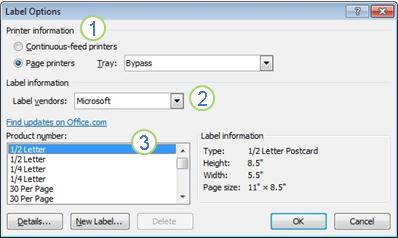
1. The type of printer that you are using to print the labels.
2. The supplier that produced your label sheets.
3. The number that corresponds to the product number listed on your package of label sheets.
-
Under Printer information, click the type of printer that you will use to print the labels.
-
In the Label vendors list, click the name of the company that made the label sheets that you are using.
-
In the Product number list, click the product number that is listed on the box of label sheets.
The product number for my label sheets doesn't match any of the choices in the Label Options dialog box.
You can still print your labels. You just have to do some customizing.
-
Measure the labels on the sheet you have, and note the measurements and how many labels fit on a single sheet.
Note: Measure the labels carefully. The actual label size might be smaller than the size that is indicated by the label manufacturer. For example, a 1-by-2-inch label might actually be 15/16-inch high and 1 15/16-inches wide.
-
In the Product number list, select a label type that is similar in size to your labels.
If you don't see the label type that you want in the Product number box, you may be able to use another of the listed labels, or you can create a new label size.
-
Click Details, and then compare the label dimensions and the number of labels per sheet (for labels printed on laser and ink-jet printers) or the number of columns on the label form (for labels printed on dot-matrix printers).
-
Do one of the following:
-
If the dimensions and label layout match those of your labels, use the selected label.
-
If the dimensions and layout do not match yours, click Cancel, and continue to step 5.
-
-
In the Label Options dialog box, click the printer type (either Continuous-feed printers or Page printers), and then click New Label.
-
Type a name in the Label name box, select the height, width, margins, and other options for your label, and then click OK.
The new label appears in the Other/Custom category. The next time you use your custom labels, be sure to select Other/Custom in the Label vendors list.
-
-
After you select the label options that you want, click OK.
Word creates a document that uses a table to lay out the labels. If you do not see lines separating the labels in the layout, click the Layout tab under Table Tools, and then in the Table group, click View Gridlines.
Interrupt and resume a mail merge
If you need to stop working on a mail merge, you can save the label main document you are working on and resume the merge later. Word retains the data source and field information in the document that you save. If you were using the Mail Merge task pane when you stopped working on the merge, Word returns to your place in the task pane when you resume the merge.
-
When you are ready to resume the merge, open the label main document that you saved.
Word displays a message box that asks you to confirm that you want to open the document and run an SQL command (the SQL command connects Word to your Excel source file).
-
Click Yes to connect to your Excel source file and retrieve your address list.
The text of your label main document, along with any fields that you inserted, appears.
-
Click the Mailings tab, and resume your work.
Step 3: Connect the labels to your worksheet data
To merge the address information into your labels, you must connect the labels to the worksheet that contains your address list.
-
If this is the first time that you have ever connected to a worksheet, do the following:
-
On the File menu, click Options.
-
Click Advanced.
-
Scroll to the General section, and select the Confirm file format conversion on open check box.
-
Click OK.
-
-
With the mail merge main document open, in the Start Mail Merge group on the Mailings tab, click Select Recipients, and then click Use Existing List.

-
Locate the Excel worksheet in the Select Data Source dialog box, and double-click it.
-
In the Confirm Data Source dialog box, click MS Excel Worksheets via DDE (*.xls), and then click OK.
Note: If you do not see MS Excel Worksheets via DDE (*.xls) in the list, select the Show all check box.
-
In the Microsoft Office Excel dialog box, for Named or cell range, select the cell range or worksheet that contains the information that you want to merge, and then click OK.
Note: The labels are now connected to the worksheet data, but the sheet of labels is still blank. If needed, you can define the list of recipients as described in step 4, or you can start populating the labels with placeholders for the address information, as described in step 5.
Step 4: Refine the list of recipients that you want to include on the labels
Word generates a label for each address in your mailing list. If you want to generate labels for only certain addresses in your mailing list, you can choose which addresses (records) to include.
To narrow the list of recipients or to use a subset of the records in your data file, do the following:
-
On the Mailings tab, in the Start Mail Merge group, click Edit Recipient List.

-
In the Mail Merge Recipients dialog box, do one of the following:
-
Select individual records This method is most useful if the list is short. Select the check boxes next to the recipients that you want to include, and clear the check boxes next to the recipients that you want to exclude.
Tip: If you know that you want to include only a few records in your merge, you can clear the check box in the header row, and then select only those records that you want. Similarly, if you want to include most of the list, select the check box in the header row, and then clear the check boxes for the records that you do not want to include.
-
Sort records Click the heading of the column that you want to sort by. Word sorts the list in ascending alphabetical order (from A to Z). Click the column heading again to sort the list in descending alphabetical order (Z to A).
To specify more advanced sorting options, click Sort under Refine recipient list, and then select your sorting preferences on the Sort Records tab in the Filter and Sort dialog box. For example, you can specify that recipient addresses must be alphabetized by last name within each postal code, and that postal codes are listed in numeric order.
-
Filter records This method is useful if the list contains records that you do not want to see or include in the merge. After you filter the list, you can select or clear the check boxes to include or exclude specific records.
To filter records, do the following:
-
Under Refine recipient list, click Filter.
-
On the Filter Records tab in the Query Options dialog box, select the criteria that you want to use to filter your records.
For example, to generate labels only for addresses in Australia, click Country or Region in the Field list, Equal to in the Comparison list, and Australia in the Compare to list.
-
To further refine the filter, click And or Or, and then select more criteria.
For example, to generate labels only for businesses in Munich, you specify records whose City field contains Munich and whose Company Name field is not blank. If you use Or instead of And in this filter, your mail merge includes all Munich addresses in addition to all addresses that include a company name, regardless of city.
-
-
If you have installed address validation software on your computer, you can click Validate addresses in the Mail Merge Recipients dialog box to validate your recipients' addresses.
Step 5: Add placeholders (mail merge fields) to the labels
After you connect your labels to your address list, you are ready to add placeholders that indicate where the addresses will appear on each label. You can also type text that you want repeated on each label, such as a company logo or your return address on a shipping label.
The placeholders for the addresses are called mail merge fields. When you perform the mail merge, the mail merge fields are filled with information from your address list. Mail merge fields in Word correspond to the column headers in your Excel worksheet.

1. Columns in a data file represent categories of information. Mail merge fields that you add to the labels are placeholders for these categories.
2. Rows in a data file represent records of information. Word generates a label for each record when you perform a mail merge.
By putting a mail merge field in the original label that you configured in the label main document, you indicate that you want a certain category of information, such as name or address, to appear in that location.
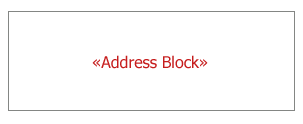
Note: When you insert a mail merge field into the label main document, the field name is always surrounded by chevrons (« »). These chevrons do not show up on the final labels — they just help you distinguish the fields in the label main document from the regular text.
What happens when you merge
When you perform the mail merge, information from the first row in the data file replaces the fields in the first label. Then, information from the second row in the data file replaces the fields in the second label, and so on.
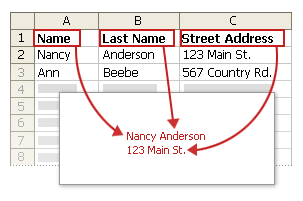
Working with fields: Examples
When you design labels, you can link any column heading from your data file to a field in a label.
For example, suppose your mailing list is for subscribers to your newsletter, and your data file includes a column, called ExpireDate, which stores the date that each subscription expires. If you insert an «ExpireDate» field in the label main document before you run the merge, subscribers will each see their own expiration date on their mailing label.
You can combine fields and separate them with punctuation marks. For example, to create an address, you can configure the fields in the label main document as follows:
«First Name» «Last Name»
«Street Address»
«City», «State» «Postal code»
For combinations that you use frequently, like address blocks and greeting lines, Word provides composite fields that group a number of fields together. For example, the Address Block field is a combination of several fields, including first name, last name, street address, city, and postal code.
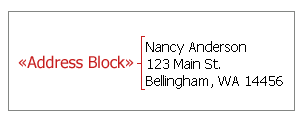
You can customize the content in each of these composite fields. For example, in the address, you may want to select a formal name format (Mr. Roger Harui). In the greeting, you might prefer to use "To" instead of "Dear."
Map the mail merge fields to your data file
To make sure that Word can find a column in your data file that corresponds to every address element, you might need to map the mail merge fields in Word to the columns in your Excel spreadsheet.
To map the fields, click Match Fields in the Write & Insert Fields group on the Mailings tab.

The Match Fields dialog box appears.
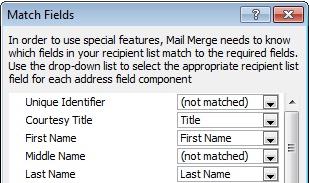
The elements of an address are listed on the left. Column headings from your data file are listed on the right.
Word searches for the column that best matches each element. As the graphic illustrates, Word automatically matched the data file's Title column to Courtesy Title, but Word was unable to match other elements, such as Middle Name.
In the list on the right, you can select the column from your data file that matches the element on the left. It is okay that Unique Identifier and Middle Name are not matched, because the mail merge label does not need to use every field. If you add a field that does not contain data from your data file, it will appear in the merged document as an empty placeholder — usually a blank line or an empty block of space.
Type the content and add the placeholders, or fields
-
In the initial label that you set up (in the label main document), type any content that you want to appear on every label.
To add a picture, such as a logo, click Picture in the Illustrations group on the Insert tab.
-
Click where you want to insert the field.
-
Use the Write & Insert Fields group on the Mailings tab.

-
Add any of the following:
Address Block with name, address, and other information
-
Click Address Block.
-
In the Insert Address Block dialog box, select the address elements that you want to include and the formats that you want to apply, and then click OK.
-
If the Match Fields dialog box appears, this means that Word is unable to find some of the information that it requires to complete the address block. Click the arrow next to (not matched), and then select the field from your data source that corresponds to the field that is required for the mail merge.
Individual fields
You can insert information from individual fields, such as first name, telephone number, or the amount of a contribution from a list of donors. To quickly add a field from your data file to the label main document, click the arrow next to Insert Merge Field, and then click the field name.
To insert other optional fields in the document, do the following:
-
On the Mailings tab, in the Write & Insert Fields group, click Insert Merge Field.
-
In the Insert Merge Field dialog box, do one of the following:
-
To select address fields that will automatically correspond to fields in your data source, even if the names of those fields are not the same as the field names in Word, click Address Fields.
-
To select fields that always take data directly from a column in your data file, click Database Fields.
-
-
In the Fields box, click the field that you want.
-
Click Insert, and then click Close.
-
If the Match Fields dialog box appears, this means that Word is unable to find some of the information that it requires to insert the field. Click the arrow next to (not matched), and then select the field from your data source that corresponds to the field that is required for the mail merge.
Note: If you insert a field from the Database Fields list and then later switch to a data source that does not contain a column with the same name, Word will be unable to insert that field information into the merged document.
Custom fields from Microsoft Office Outlook contacts
The only way to include custom contact fields in your main document is to start the mail merge from within Outlook. First set up a view of your contacts with the fields that you want to use in the merge. Then start the mail merge. After you choose the settings that you want, Word automatically starts, and you can complete the merge.
Set up a view of your contacts that includes custom fields
-
In Outlook Contacts, on the View tab, click Change View, and then click List.
-
Right-click a column heading, and then click Field Chooser on the shortcut menu.
-
In the drop-down list at the top of the Field Chooser dialog box, select User-defined fields in folder.
-
Drag the field that you to add from the dialog box to the column headings. A little red arrow helps you place the field in the location that you want.
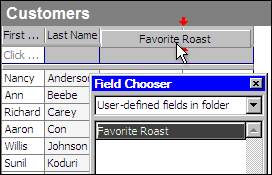
Note: You can add a new field in the Field Chooser dialog box by clicking New at the bottom.
-
After you add all of your custom fields to the view, close the Field Chooser dialog box.
-
To remove a field that you do not want included in the mail merge, click the field name in the column heading in List view, and drag it off the column heading.
Run the mail merge from Outlook
-
In Outlook Contacts, select individual contacts by holding down SHIFT and clicking to select a range or by holding down CTRL and clicking to select individuals. If you want to include all the contacts currently visible in the view, do not click any contacts.
-
On the Home tab, click Mail Merge.
-
If you selected individual contacts to include in the mail merge, click Only selected contacts. If you want to include all the contacts that are currently visible in the view, click All contacts in current view.
-
If you configured the List view so that it displays exactly the fields that you want to use in the mail merge, click Contact fields in current view. Otherwise, click All contact fields to make all of the contact fields available in the mail merge.
-
If you want to generate a new main document for the mail merge, click New document. Otherwise, click Existing document, and then click Browse to locate the document to use as the main document.
-
If you want to save the contacts and fields that you selected so that they can be reused, select the Permanent file check box, and then click Browse to save the file. The data is saved in a Word document as comma-delimited data.
-
Under Document type, click Mailing Labels.
-
Click OK. When the document opens in Word, on the Mailings tab in the Write & Insert Fields group, click the arrow next to Insert Merge Field, and then click the fields that you want to add to the label main document.
-
-
After you finish setting up the first label the way you want it, in the Write & Insert Fields group, click Update Labels.
Word replicates the layout of the first label to all the other labels.
-
You cannot type merge field characters («« »») manually or use the Symbol command on the Insert menu in Word. You must use mail merge.
-
If the merge fields appear inside braces, such as {MERGEFIELD City }, Word is displaying field codes instead of field results. This doesn't affect the mail merge, but if you want to display the results instead, right-click the field code, and then click Toggle Field Codes.
Format the merged data
Database and spreadsheet programs, such as Access and Excel, store the information that you type in cells as raw data. Formatting, such as fonts and colors, that you apply in Access or Excel is not stored with the raw data. When you merge information from a data file into a Word document, you are merging the raw data without the applied formatting.
To format the data in the document, select the mail merge field and format it, just as you would format any text. Make sure that the selection includes the chevron characters (« ») that surround the field.
Step 6: Preview and print the labels
After you have added the fields to the original label that you configured in the label main document, you are ready to preview the mail merge results. After you are satisfied with the preview, you complete the mail merge and print the labels. You can then save the label main document for future use.
Preview the mail merge
You can preview your labels and make changes before you actually complete the mail merge.
To preview, do any of the following in the Preview Results group of the Mailings tab:

-
Click Preview Results.
-
Page through each label by clicking the Next Record and Previous Record buttons in the Preview Results group on the Mailings tab.
-
Preview a specific label document by clicking Find Recipient.
Note: Click Edit Recipient List in the Start Mail Merge group on the Mailings tab to open the Mail Merge Recipients dialog box, where you can filter the list or remove recipients from the merge if you see records that you do not want to include.

Note: Word uses a table to lay out a sheet of labels on the page. As you page through the labels, the active record is displayed in the first cell of the table, with the following records displayed in subsequent cells.
Complete the mail merge
To print the labels, do the following:
-
On the Mailings tab, in the Finish group, click Finish & Merge, and then click Print Documents.

-
Choose whether to print the whole set of labels, only the label that is currently visible, or a specific subset of the labels.
To change individual labels, do the following:
-
On the Mailings tab, in the Finish group, click Finish & Merge, and then click Edit Individual Documents.

-
Choose whether you want to edit the whole set of labels, only the label that is currently visible, or a specific subset of the labels. Word saves the labels that you want to edit to a separate file.
Step 7: Save the labels for future use
Remember that the merged labels that you save are separate from the original label that you configured in the label main document. It is a good idea to save the label main document itself if you plan to use it for another mail merge.
When you save the label main document, you also save its connection to the data file. The next time that you open the label main document, Word will prompt you to choose whether or not to merge the information from the data file into the label main document again.
-
Click Yes to open the document with the information from the first record that was merged in.
-
Click No to have Word break the connection between the label main document and the data file, reformat the label main document as a standard Word document, and replace the fields with the unique information from the first record.
No comments:
Post a Comment